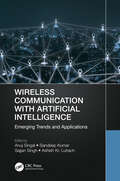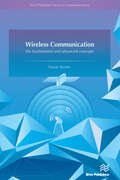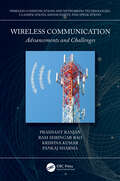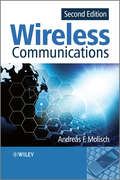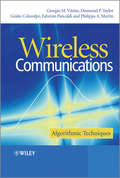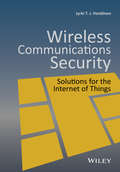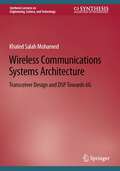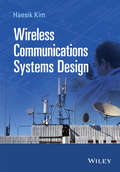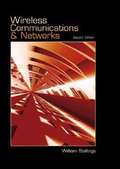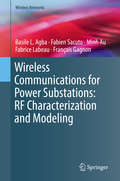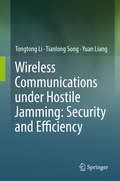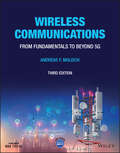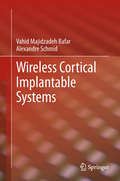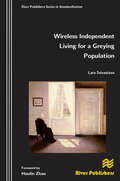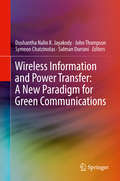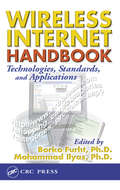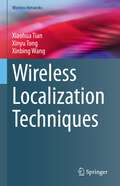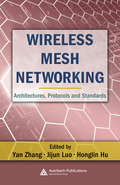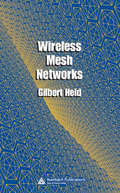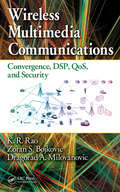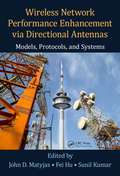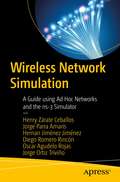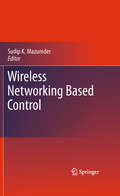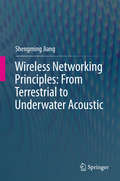- Table View
- List View
Wireless Communication with Artificial Intelligence: Emerging Trends and Applications (Wireless Communications and Networking Technologies)
by Sandeep Kumar Anuj Singal Sajjan Singh Ashish Kr. LuhachThis reference text discusses advances in wireless communication, design challenges, and future research directions to design reliable wireless communication. The text discusses emerging technologies including wireless sensor networks, Internet of Things (IoT), cloud computing, mm-Wave, Massive MIMO, cognitive radios (CR), visible light communication (VLC), wireless optical communication, signal processing, and channel modeling. The text covers artificial intelligence-based applications in wireless communication, machine learning techniques and challenges in wireless sensor networks, and deep learning for channel and bandwidth estimation during optical wireless communication. The text will be useful for senior undergraduate, graduate students, and professionals in the fields of electrical engineering, and electronics and communication engineering.
Wireless Communication-the fundamental and advanced concepts (River Publishers Series In Communications Ser.)
by Sanjay KumarWireless communication is one of the fastest growing fields in the engineering world today. Rapid growth in the domain of wireless communication systems, services and application has drastically changed the way we live, work and communicate. Wireless communication offers a broad and dynamic technological field, which has stimulated incredible excitements and technological advancements over last few decades. The expectations from wireless communication technology are increasing every day. This is placing enormous challenges to wireless system designers. Moreover, this has created an ever increasing demand for conceptually strong and well versed communication engineers who understand the wireless technology and its future possibilities. In recent years, significant progress in wireless communication system design has taken place, which will continue in future. Especially for last two decades, the research contributions in wireless communication system design have resulted in several new concepts and inventions at remarkable speed. A text book is indeed required to offer familiarity with such developments and underlying concepts, to be taught in the classroom to future engineers. This is one of the motivations for writing this book. Practically no book can be up to date in this field, due to the fast ongoing research and developments. The new developments are announced almost every day. Teaching directly from the research papers in the classroom cannot build the necessary foundation. Therefore need for a textbook is unavoidable, which is integral to learning, and is an essential source to build the concept. The prime goal of this book is to cooperate in the learning process.
Wireless Communication: Advancements and Challenges (Wireless Communications and Networking Technologies)
by Krishna Kumar Pankaj Sharma Prashant Ranjan Ram Shringar RaoThis reference text will benefit readers in enhancing their understanding of the recent technologies, protocols, and challenges in various stages of development of wireless communication and networking. The text discusses the cellular concepts of 4G, 5G, and 6G along with their challenges. It covers topics related to vehicular technology, wherein vehicles communicate with the traffic and the environment around them using short-range wireless signals. The text comprehensively covers important topics including use of the Internet of Things (IoT) in wireless communication, architecture, and protocols. It further covers the role of smart antennas in emerging wireless technologies. The book Discusses advanced techniques used in the field of wireless communication. Covers technologies including network slicing, 5G wireless communication, and TV white space technology. Discusses practical applications including drone delivery systems, public safety, IoT, virtual reality, and smart cities. Covers radio theory and applications for wireless communication with ranges of centimeters to hundreds of meters. Discusses important topics including metamaterials, inductance coupling for loop antennas, bluetooth low energy, wireless security, and wireless sensor networks. Discussing latest technologies including 5G, 6G, IoT, vehicular technology and TV white space technology, this text will be useful for senior undergraduate, graduate students, and professionals in the fields of electrical engineering, and electronics and communication engineering.
Wireless Communications
by Andreas F. Molisch"Professor Andreas F. Molisch, renowned researcher and educator, has put together the comprehensive book, Wireless Communications. The second edition, which includes a wealth of new material on important topics, ensures the role of the text as the key resource for every student, researcher, and practitioner in the field."--Professor Moe Win, MIT, USAWireless communications has grown rapidly over the past decade from a niche market into one of the most important, fast moving industries. Fully updated to incorporate the latest research and developments, Wireless Communications, Second Edition provides an authoritative overview of the principles and applications of mobile communication technology.The author provides an in-depth analysis of current treatment of the area, addressing both the traditional elements, such as Rayleigh fading, BER in flat fading channels, and equalisation, and more recently emerging topics such as multi-user detection in CDMA systems, MIMO systems, and cognitive radio. The dominant wireless standards; including cellular, cordless and wireless LANs; are discussed.Topics featured include: wireless propagation channels, transceivers and signal processing, multiple access and advanced transceiver schemes, and standardised wireless systems.Combines mathematical descriptions with intuitive explanations of the physical facts, enabling readers to acquire a deep understanding of the subject.Includes new chapters on cognitive radio, cooperative communications and relaying, video coding, 3GPP Long Term Evolution, and WiMax; plus significant new sections on multi-user MIMO, 802.11n, and information theory.Companion website featuring: supplementary material on 'DECT', solutions manual and presentation slides for instructors, appendices, list of abbreviations and other useful resources.
Wireless Communications
by Giorgio Vitetta Fabrizio Pancaldi Philippa A. Martin Desmond P. Taylor Giulio ColavolpeThis book introduces the theoretical elements at the basis of various classes of algorithms commonly employed in the physical layer (and, in part, in MAC layer) of wireless communications systems. It focuses on single user systems, so ignoring multiple access techniques. Moreover, emphasis is put on single-input single-output (SISO) systems, although some relevant topics about multiple-input multiple-output (MIMO) systems are also illustrated.Comprehensive wireless specific guide to algorithmic techniquesProvides a detailed analysis of channel equalization and channel coding for wireless applicationsUnique conceptual approach focusing in single user systemsCovers algebraic decoding, modulation techniques, channel coding and channel equalisation
Wireless Communications Security: Solutions for the Internet of Things
by Jyrki T. PenttinenThe development of the wireless communications environment, especially as related to security, has been relatively stable compared to the issues of fixed Internet. Nevertheless, along with the enhanced functionalities of smart devices, networks and applications, the level of malicious attacks has increased considerably. It can be estimated that security attacks, distribution of viruses and other malicious activities increase in the wireless environment along with the higher number of users. Not only are payment activities, person-to-person communications and social media utilization under constant threat, but furthermore, one of the strongly increasing security risks is related to M2M (Machine-to-Machine) communications. This book describes the current and most probable future wireless security solutions. The focus is on the technical discussion of existing systems and new trends like Internet of Things (IoT). It also discusses existing and potential security threats, presents methods for protecting systems, operators and end-users, describes security systems attack types and the new dangers in the ever-evolving Internet. The book functions as a practical guide describing the evolvement of the wireless environment, and how to ensure the fluent continuum of the new functionalities, whilst minimizing the potential risks in network security.
Wireless Communications Systems Architecture: Transceiver Design and DSP Towards 6G (Synthesis Lectures on Engineering, Science, and Technology)
by Khaled Salah MohamedThis book discusses wireless communication systems from a transceiver and digital signal processing perspective. It is intended to be an advanced and thorough overview for key wireless communication technologies. A wide variety of wireless communication technologies, communication paradigms and architectures are addressed, along with state-of-the-art wireless communication standards. The author takes a practical, systems-level approach, breaking up the technical components of a wireless communication system, such as compression, encryption, channel coding, and modulation. This book combines hardware principles with practical communication system design. It provides a comprehensive perspective on emerging 5G mobile networks, explaining its architecture and key enabling technologies, such as M-MIMO, Beamforming, mmWaves, machine learning, and network slicing. Finally, the author explores the evolution of wireless mobile networks over the next ten years towards 5G and beyond (6G), including use-cases, system requirements, challenges and opportunities.
Wireless Communications Systems Design
by Haesik KimWireless Communications Systems Design provides the basic knowledge and methodology for wireless communications design. The book mainly focuses on a broadband wireless communication system based on OFDM/OFDMA system because it is widely used in the modern wireless communication system. It is divided into three parts: wireless communication theory (part I), wireless communication block design (part II), and wireless communication block integration (part III). Written by an expert with various experience in system design (standards, research and development)
Wireless Communications and Networks, Second Edition
by William StallingsWireless Communications and Networks, 2e, provides one of the most up-to-date and accurate overviews of wireless principles, technology, and application. It is ideal for courses in wireless networking, wireless communications, wireless data communications or wireless technology in departments of Computer Science, Engineering, IT, and Continuing Education. The rapid growth of mobile telephone use, satellite services, and the wireless Internet are generating tremendous changes in telecommunications and networking. Combining very current technical depth with a strong pedagogy and advanced Web support, this new edition provides a comprehensive guide to wireless technology--exploring key topics such as technology and architecture, network types, design approaches, and the latest applications.
Wireless Communications for Power Substations: RF Characterization and Modeling (Wireless Networks)
by Basile L. Agba Fabien Sacuto Minh Au Fabrice Labeau François GagnonThis book consists of the identification, characterization, and modeling of electromagnetic interferences in substations for the deployment of wireless sensor networks. The authors present in chapter 3 the measurement setup to record sequences of impulsive noise samples in the ISM band of interest. The setup can measure substation impulsive noise, in wide band, with enough samples per time window and enough precision to allow a statistical study of the noise. During the measurement campaign, the authors recorded around 120 noise sequences in different substations and for four ranges of equipment voltage, which are 25 kV, 230 kV, 315 kV and 735 kV. A characterization process is proposed, by which physical characteristics of partial discharge can be measured in terms of first- and second-order statistics. From the measurement campaign, the authors infer the characteristics of substation impulsive noise as a function of the substation equipment voltage, and can provide representative parameters for the four voltage ranges and for several existing impulsive noise models.The authors investigate in chapters 4 and 5 the modeling of electromagnetic interferences caused by partial discharge sources. First, the authors propose a complete and coherent approach model that links physical characteristics of high-voltage installations to the induced radio-interference spectra of partial discharge sources. The goodness-of-fit of the proposed physical model has been measured based on some interesting statistical metrics. This allows one to assess the effectiveness of the authors' approach in terms of first- and second-order statistics. Chapter 6 proposes a model based on statistical approach. Indeed, substation impulsive noise is composed of correlated impulses, which would require models with memory in order to replicate a similar correlation. Among different models, we have configured a Partitioned Markov Chain (PMC) with 19 states (one state for the background noise and 18 states for the impulse); this Markov-Gaussian model is able to generate impulsive noise with correlated impulse samples. The correlation is observable on the impulse duration and the power spectrum of the impulses. Our PMC model provides characteristics that are more similar to the characteristics of substation impulsive noise in comparison with other models, in terms of time and frequency response, as well as Probability Density Functions (PDF). Although PMC represents reliably substation impulsive noise, the model remains complex in terms of parameter estimation due to a large number of Markov states, which can be an obstacle for future wireless system design. In order to simplify the model, the authors decrease the number of states to 7 by assigning one state to the background noise and 6 states to the impulse and we call this model PMC-6. PMC-6 can generate realistic impulses and can be easily implemented in a receiver in order to mitigate substation impulsive noise. Representative parameters are provided in order to replicate substation impulsive noise for different voltage ranges (25-735 kV). Chapter 7, a generalized radio-noise model for substations is proposed, in which there are many discharges sources that are randomly distributed over space and time according to the Poisson field of interferers approach. This allows for the identification of some interesting statistical properties of moments, cumulants and probability distributions. These can, in turn, be utilized in signal processing algorithms for rapid partial discharge's identification, localization, and impulsive noise mitigation techniques in wireless communications in substations.The primary audience for this book is the electrical and power engineering industry, electricity providers and companies who are interested in substation automation systems using wireless communication technologies for smart grid applications. Researchers, engineers and students studying and working in wireless communication will also want to buy this book as a reference.
Wireless Communications under Hostile Jamming: Security and Efficiency
by Tongtong Li Tianlong Song Yuan LiangThis monograph is intended for the designers and would-be designers of secure and efficient wireless communication systems under intentional interference. Along with the widespread of wireless devices, especially reconfigurable software defined radios, jamming has become a serious threat to civilian communications. In this book, going beyond traditional communication system design that mainly focuses on accurate information transmission under benign environments, we aim to enhance the physical layer security of communication systems by integrating modern cryptographic techniques into transceiver design, so as to achieve secure high-speed transmission under hostile interference with high reliability and efficiency. We revisit existing jamming patterns, and introduce new jamming patterns. We analyze the weaknesses of existing anti-jamming techniques. We present innovative and feasible anti-jamming techniques, which can strengthen the inherent security of the 3G, 4G and the upcoming 5G systems with minimal and inexpensive changes to the existing CDMA, frequency hopping and OFDM schemes. We also provide benchmarks for system performance evaluation under various jamming scenarios through capacity analysis. This book includes design principles, in-depth theoretical analysis and practical design examples, and will be of interest to academic researchers as well as professionals in industry.
Wireless Communications: From Fundamentals to Beyond 5G (IEEE Press)
by Andreas F. MolischAn in-depth and comprehensive treatment of wireless communication technology ranging from the fundamentals to the newest research results The expanded and completely revised Third Edition of Wireless Communications delivers an essential text in wireless communication technology that combines mathematical descriptions with intuitive explanations of the physical facts that enable readers to acquire a deep understanding of the subject. This latest edition includes brand-new sections on cutting edge research topics such as massive MIMO, polar codes, heterogeneous networks, non-orthogonal multiple access, as well as 5G cellular standards, WiFi 6, and Bluetooth Low Energy. Together with the re-designed descriptions of fundamentals such as fading, OFDM, and multiple access, it provides a thorough treatment of all the technologies that underlie fifth-generation and beyond systems. A complimentary companion website provides readers with a wealth of old and new material, including instructor resources available upon request. Readers will also find: A thorough introduction to the applications and requirements of modern wireless services, including video streaming, virtual reality, and Internet of Things. Comprehensive explorations of wireless propagation mechanisms and channel models, ranging from Rayleigh fading to advanced models for MIMO communications. Detailed discussions of single-user communications fundamentals, including modern coding techniques, multi-carrier communications, and single-user MIMO. Extensive description of multi-user communications, including packet radio systems, CDMA, scheduling, admission control, cellular and ad-hoc network design, and multi-user MIMO. In-depth examinations of advanced topics in wireless communication, like speech and video coding, cognitive radio, NOMA, network coding, and wireless localization. A comprehensive description of the key wireless standards, including LTE, 5G, WiFi, Bluetooth, and an outlook to Beyond 5G systems. Perfect for advanced undergraduate and graduate students with a basic knowledge of standard communications, Wireless Communications will also earn a place in the libraries of researchers and system designers seeking a one-stop resource on wireless communication technology.
Wireless Cortical Implantable Systems
by Vahid Majidzadeh Bafar Alexandre SchmidWireless Cortical Implantable Systems examines the design for data acquisition and transmission in cortical implants. The first part of the book covers existing system level cortical implants, as well as future devices. The authors discuss the major constraints in terms of microelectronic integrations are presented. The second part of the book focuses on system-level as well as circuit and system level solutions to the development of ultra low-power and low-noise microelectronics for cortical implants. Existing solutions are presented and novel methods and solutions proposed. The third part of the book focuses on the usage of digital impulse radio ultra wide band transmission as an efficient method to transmit cortically neural recorded data at high data rate to the outside world. Original architectural and circuit and system solutions are discussed.
Wireless Independent Living for a Greying Population (River Publishers Series In Standardisation Ser.)
by Lara SrivastavaIt is widely known today that not only are the aged ageing, or the old getting older, but they are also increasing in number the world over. At the same time, proper care and support for our aged is increasingly at risk. Without some form of support, the quantitative extension of life cannot be matched by a qualitative one. This may mean that the opportunity provided by a longer life is squandered, and life itself, of course, is nothing if not opportunity. Societies find that self-sufficiency and independence not only contribute to individual well-being, but are also economically desirable due to the resultant increase in productivity.The challenges of daily living for a growing population of the aged form the basis of the independent living platform, the AGE@HOME platform, which is described in this book. The platform combines both existing and emerging technologies suitable for the home. Its use and application is considered in the wider context of Web 2.0, the internet of things, and other elements of the burgeoning digital world. It is time that a holistic and multi-disciplinary approach to this constantly enlarging area of human existence is taken.This book is written for researchers and designers of wireless tools, analog and digital circuits as well as academics who are active in the various fields of Human Sciences.Foreword"This book appears at the right moment when several developments have made age and its consequences an important element of human existence. It makes for informative reading, being based on considerations related to independence for the aged and the application of emerging technologies to enhance this independence......."From the foreword by:Houlin ZhaoDeputy Secretary-General of theInternational Telecommunication Union
Wireless Indoor Localization: A Crowdsourcing Approach
by Yunhao Liu Zheng Yang Chenshu WuThis book provides a comprehensive and in-depth understanding of wireless indoor localization for ubiquitous applications. The past decade has witnessed a flourishing of WiFi-based indoor localization, which has become one of the most popular localization solutions and has attracted considerable attention from both the academic and industrial communities. Specifically focusing on WiFi fingerprint based localization via crowdsourcing, the book follows a top-down approach and explores the three most important aspects of wireless indoor localization: deployment, maintenance, and service accuracy. After extensively reviewing the state-of-the-art literature, it highlights the latest advances in crowdsourcing-enabled WiFi localization. It elaborated the ideas, methods and systems for implementing the crowdsourcing approach for fingerprint-based localization. By tackling the problems such as: deployment costs of fingerprint database construction, maintenance overhead of fingerprint database updating, floor plan generation, and location errors, the book offers a valuable reference guide for technicians and practitioners in the field of location-based services. As the first of its kind, introducing readers to WiFi-based localization from a crowdsourcing perspective, it will greatly benefit and appeal to scientists and researchers in mobile and ubiquitous computing and related areas.
Wireless Information and Power Transfer: A New Paradigm for Green Communications
by John Thompson Dushantha Nalin K. Jayakody Symeon Chatzinotas Salman DurraniThis book presents breakthroughs in the design of Wireless Energy Harvesting (WEH) networks. It bridges the gap between WEH through radio waves communications and power transfer, which have largely been designed separately. The authors present an overview of the RF-EHNs including system architecture and RF energy harvesting techniques and existing applications. They also cover the idea of WEH in novel discoveries of information, the theoretical bounds in WEH, wireless sensor networks, usage of modern channel coding together with WEH, energy efficient resource allocation mechanisms, distributed self-organized energy efficient designs, delay-energy trade-off, specific protocols for energy efficient communication designs, D2D communication and energy efficiency, cooperative wireless networks, and cognitive networks.
Wireless Internet Handbook: Technologies, Standards, and Applications (Internet And Communications)
by Borko Furht and Mohammad IlyasWireless applications are definitely the next big thing in communications. Millions of people around the world use the Internet every day - to stay in touch with remote locations, follow the stock market, keep up with the news, check the weather, make travel plans, conduct business, shop, entertain themselves, and learn. The logical next step is th
Wireless Localization Techniques (Wireless Networks)
by Xinbing Wang Xiaohua Tian Xinyu TongThis book first presents a systematic theoretical study of wireless localization techniques. Then, guided by the theoretical results, the authors provide design approaches for improving the performance of localization systems and making the deployment of the systems more convenient. The book aims to address the following issues: how reliable the wireless localization system can be; how the system can scale up with the number of users to be served; how to make key design decisions in implementing the system; and how to mitigate human efforts in deploying the wireless localization system. The book is relevant for researchers, academics, and students interested in wireless localization technology.
Wireless Mesh Networking: Architectures, Protocols and Standards (Wireless Networks and Mobile Communications)
by Yan Zhang Honglin Hu Jijun LuoA promising new technology, wireless mesh networks are playing an increasingly important role in the future generations of wireless mobile networks. Characterized by dynamic self-organization, self-configuration, and self-healing to enable quick deployment, easy maintenance, low cost, high scalability, and reliable services, this technology is beco
Wireless Mesh Networks
by Gilbert HeldWireless mesh networking is a new technology that has the potential to revolutionize how we access the Internet and communicate with co-workers and friends. Wireless Mesh Networks examines the concept and explores its advantages over existing technologies. This book explores existing and future applications.
Wireless Multimedia Communications: Convergence, DSP, QoS, and Security
by K.R. Rao Zoran S. Bojkovic Dragorad A. MilovanovicWith the rapid evolution of multimedia communications, engineers and other professionals are generally forced to hoard a plethora of different texts and journals to maintain a solid grasp on essential ideas and techniques in the field. Wireless Multimedia Communications provides researchers and students with a primary reference to help readers take maximum advantage of current systems and uncover opportunities to propose new and novel protocols, applications, and services. Extract the Essentials of System Design, Analysis, ImplementationA complete technical reference, the text condenses the essential topics of core wireless multimedia communication technologies, convergence, QoS, and security that apply to everything from networking to communications systems, signal processing, and security. From extensive existing literature, the authors distill the central tenets and primary methods of analysis, design, and implementation, to reflect the latest technologies and architectural concepts. The book addresses emerging challenges to inform the system standardization process and help engineers combat the high error rates and stringent delay constraints that remain a significant challenge to various applications and services. Keep Pace with Detailed Techniques to Optimize TechnologyThe authors identify causes of information loss in point-to-point signal transmission through wireless channels, and then they discuss techniques to minimize that loss. They use examples that illustrate the differences in implementing various systems, ranging from cellular voice telephony to wireless Internet access. Each chapter has been carefully organized with the latest information to serve dual purposes as an easy-to-reference guide for professionals and as a principal text for senior-level university students.
Wireless Network Performance Enhancement via Directional Antennas: Models, Protocols, and Systems
by Sunil Kumar Fei Hu John D. MatyjasDirectional antenna technologies have made significant advancements in the last decade. These advances have opened the door to many exciting new design opportunities for wireless networks to enhance quality of service (QoS), performance, and network capacity. In this book, experts from around the world present the latest research and development in
Wireless Network Simulation: A Guide using Ad Hoc Networks and the ns-3 Simulator
by Henry Zárate Ceballos Jorge Ernesto Parra Amaris Hernan Jiménez Jiménez Diego Alexis Romero Rincón Oscar Agudelo Rojas Jorge Eduardo Ortiz TriviñoLearn to run your own simulation by working with model analysis, mathematical background, simulation output data, and most importantly, a network simulator for wireless technology. This book introduces the best practices of simulator use, the techniques for analyzing simulations with artificial agents and the integration with other technologies such as Power Line Communications (PLC).Network simulation is a key technique used to test the future behavior of a network. It’s a vital development component for the development of 5G, IoT, wireless sensor networks, and many more. This book explains the scope and evolution of the technology that has led to the development of dynamic systems such as Internet of Things and fog computing. You'll focus on the ad hoc networks with stochastic behavior and dynamic nature, and the ns-3 simulator. These are useful open source tools for academics, researchers, students and engineers to deploy telecommunications experiments, proofs and new scenarios with a high degree of similarity with reality. You'll also benefit from a detailed explanation of the examples and the theoretical components needed to deploy wireless simulations or wired, if necessary.What You’ll LearnReview best practices of simulator usesUnderstand techniques for analyzing simulations with artificial agentsApply simulation techniques and experiment designProgram on ns-3 simulatorAnalyze simulation resultsCreate new modules or protocols for wired and wireless networksWho This Book Is ForUndergraduate and postgraduate students, researchers and professors interested in network simulations. This book also includes theoretical components about simulation, which are useful for those interested in discrete event simulation DES, general theory of simulation, wireless simulation and ns-3 simulator.
Wireless Networking Based Control
by Sudip K. MazumderThis book will have a broad appeal in the area of Wireless Networking-Based Control. Various engineering disciplines, control and communication science organizations will be interested in purchasing the book with a new, emerging, and important theme. Also, industry such as Honeywell and those (e.g. power industry, automotive industry, aerospace industry) interested in implementing wireless network control to express interest in purchasing this book.
Wireless Networking Principles: From Terrestrial to Underwater Acoustic
by Shengming JiangThis book systematically summarizes the fundamentals and various technologies in both terrestrial radio wireless networks and underwater acoustic networks (UWANs). It addresses the basic issues frequently investigated in terrestrial radio wireless networks and the key technologies suitable for the newly developing research area of UWANs. Starting with a review of our current understanding of wireless networks, it then introduces the principles of the main technologies, including error control, medium access control (MAC) protocols, routing protocols, end-to-end transmission control and mobility issues as well as network security for terrestrial radio wireless networks, and offers detailed surveys of these technologies for UWANs.Providing readers with the basic knowledge of terrestrial radio wireless networking technologies and raising readers’ awareness of the developing topic of UWANs in ocean , it is a valuable resource for researchers and practitioners in terrestrial radio wireless networks and UWANs.
